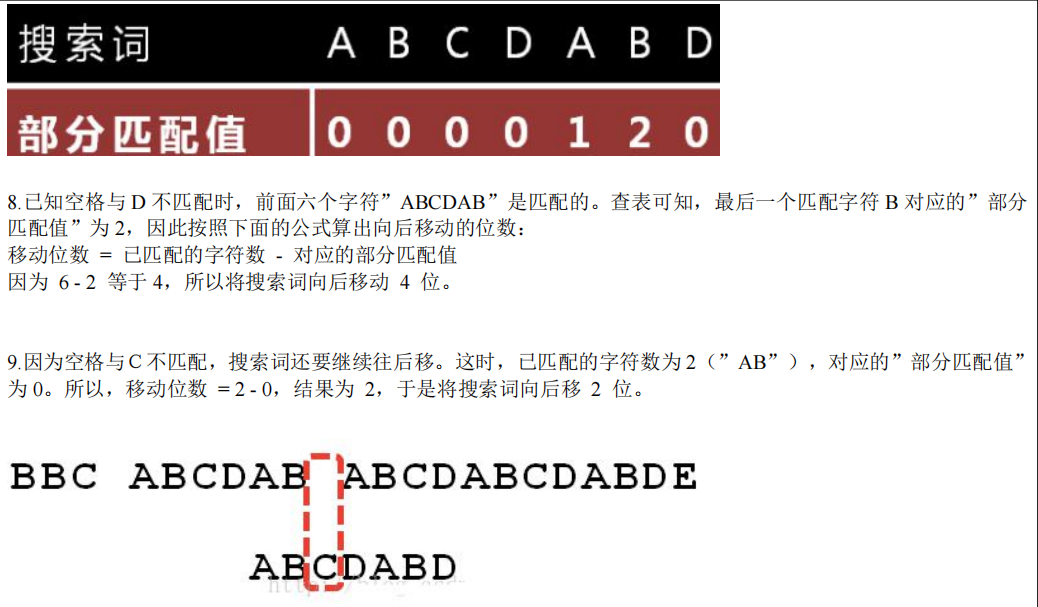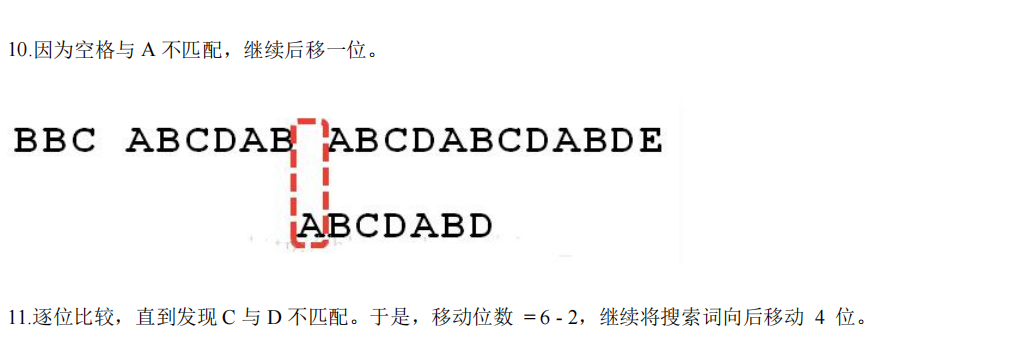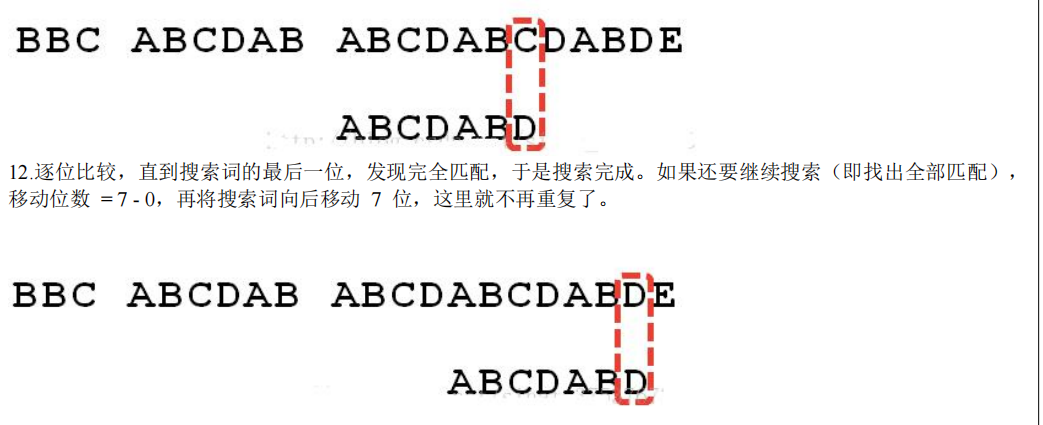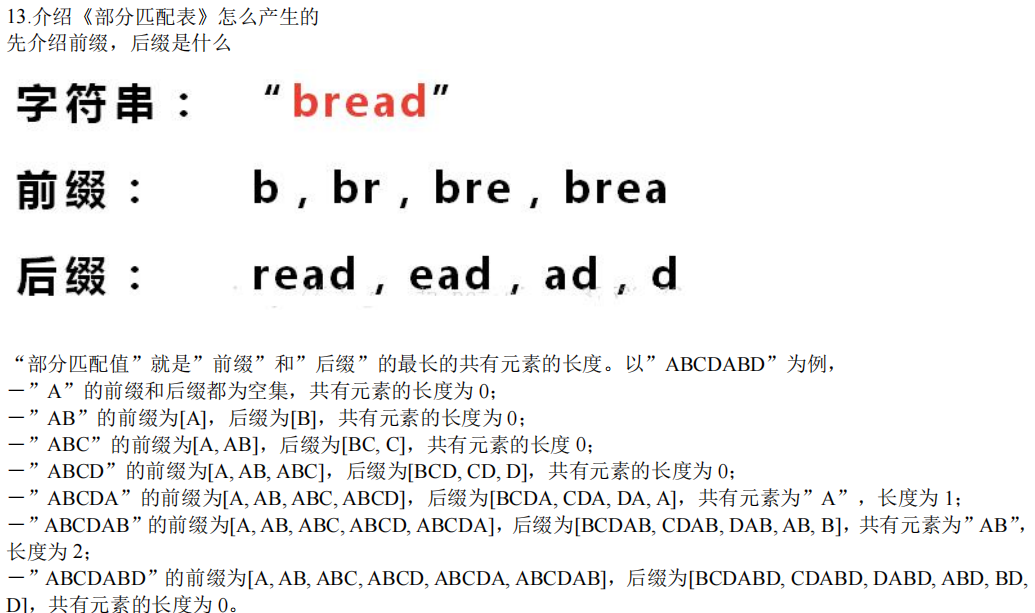KMP算法 字符串匹配
应用场景-字符串匹配问题
字符串匹配问题:
str1= "BBC ABCDAB ABCDABCDABDE",和一个子串
str2="ABCDABD"
现在要判断 str1 是否含有 str2, 如果存在,就返回第一次出现的位置,如果没有,则返回-1
暴力匹配算法
如果用暴力匹配的思路,并假设现在 str1 匹配到 i 位置,子串 str2 匹配到
j 位置,则有:
1)如果当前字符匹配成功(即 str1[i] == str2[j]),则 i++,j++,继续匹配下一个字符
2)如果失配(即 str1[i]! = str2[j]),令 i = i - (j - 1),j = 0。相当于每次匹配失败时,i 回溯,j 被置为 0。
3)用暴力方法解决的话就会有大量的回溯,每次只移动一位,若是不匹配,移动到下一位接着判断,浪费了大量
的时间。(不可行!)
4)暴力匹配算法实现.
public class ViolenceMatch {
public static void main(String[] args) {
// TODO Auto-generated method stub
//测试暴力匹配算法
String str1 = "BBC ABCDAB ABCDABCDABDE";
String str2 = "ABCDABD";
int index = violenceMatch(str1, str2);
System.out.println("index=" + index);
}
// 暴力匹配算法实现
public static int violenceMatch(String str1, String str2) {
char[] s1 = str1.toCharArray();
char[] s2 = str2.toCharArray();
int s1Len = s1.length;
int s2Len = s2.length;
int i = 0; // i索引指向s1
int j = 0; // j索引指向s2
while (i < s1Len && j < s2Len) {// 保证匹配时,不越界
if(s1[i] == s2[j]) {//匹配ok
i++;
j++;
} else { //没有匹配成功
//如果失配(即str1[i]! = str2[j]),令i = i - (j - 1),j = 0。
i = i - (j - 1);
j = 0;
}
}
//判断是否匹配成功
if(j == s2Len) {
return i - j;
} else {
return -1;
}
}
}
KMP 算法介绍
1)KMP 是一个解决模式串在文本串是否出现过,如果出现过,最早出现的位置的经典算法
2)Knuth-Morris-Pratt 字符串查找算法,简称为 “KMP 算法”,常用于在一个文本串 S 内查找一个模式串 P 的
出现位置,这个算法由 Donald Knuth、Vaughan Pratt、James H. Morris 三人于 1977 年联合发表,故取这 3 人的
姓氏命名此算法.
3)KMP 方法算法就利用之前判断过信息,通过一个 next 数组,保存模式串中前后最长公共子序列的长度,每次
回溯时,通过 next 数组找到,前面匹配过的位置,省去了大量的计算时间
KMP 算法最佳应用-字符串匹配问题
字符串匹配问题::
1)有一个字符串 str1= "BBC ABCDAB ABCDABCDABDE",和一个子串
str2="ABCDABD"
2)现在要判断 str1 是否含有 str2, 如果存在,就返回第一次出现的位置,
如果没有,则返回-1
3)要求:使用 KMP 算法完成判断,不能使用简单的暴力匹配算法.
思路分析图解








代码实现
import java.util.Arrays;
public class KMPAlgorithm {
public static void main(String[] args) {
// TODO Auto-generated method stub
String str1 = "BBC ABCDAB ABCDABCDABDE";
String str2 = "ABCDABD";
//String str2 = "BBC";
int[] next = kmpNext("ABCDABD"); //[0, 1, 2, 0]
System.out.println("next=" + Arrays.toString(next));
int index = kmpSearch(str1, str2, next);
System.out.println("index=" + index); // 15了
}
//写出我们的kmp搜索算法
/**
*
* @param str1 源字符串
* @param str2 子串
* @param next 部分匹配表, 是子串对应的部分匹配表
* @return 如果是-1就是没有匹配到,否则返回第一个匹配的位置
*/
public static int kmpSearch(String str1, String str2, int[] next) {
//遍历
for(int i = 0, j = 0; i < str1.length(); i++) {
//需要处理 str1.charAt(i) != str2.charAt(j), 去调整j的大小
//KMP算法核心点, 可以验证...
while( j > 0 && str1.charAt(i) != str2.charAt(j)) {
j = next[j-1];
}
if(str1.charAt(i) == str2.charAt(j)) {
j++;
}
if(j == str2.length()) {//找到了 // j = 3 i
return i - j + 1;
}
}
return -1;
}
//获取到一个字符串(子串) 的部分匹配值表
public static int[] kmpNext(String dest) {
//创建一个next 数组保存部分匹配值
int[] next = new int[dest.length()];
next[0] = 0; //如果字符串是长度为1 部分匹配值就是0
for(int i = 1, j = 0; i < dest.length(); i++) {
//当dest.charAt(i) != dest.charAt(j) ,我们需要从next[j-1]获取新的j
//直到我们发现 有 dest.charAt(i) == dest.charAt(j)成立才退出
//这时kmp算法的核心点
while(j > 0 && dest.charAt(i) != dest.charAt(j)) {
j = next[j-1];
}
//当dest.charAt(i) == dest.charAt(j) 满足时,部分匹配值就是+1
if(dest.charAt(i) == dest.charAt(j)) {
j++;
}
next[i] = j;
}
return next;
}
}




 浙公网安备 33010602011771号
浙公网安备 33010602011771号